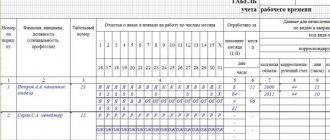The most unpleasant situation in a company's production process is the suspension of activities, i.e. downtime. This term can be deciphered as forced inaction. Downtime can occur due to various circumstances, and since such a situation is atypical, the responsibility for its formation must fall on someone. Legislators consider three main criteria, placing the blame for downtime on the employer, employee, or stating reasons for the suspension of production independent of these parties.
Determining who is responsible for downtime significantly affects the payment of staff, which is why this issue is so important. Our publication examines all the nuances of registration and payment for downtime due to the fault of the employer, let’s talk about this in detail.
Article 157 of the Labor Code of the Russian Federation on payment for downtime
Art.
157 of the Labor Code of the Russian Federation (hereinafter referred to as the Labor Code of the Russian Federation) is devoted to payment for downtime. It establishes the rules by which payment for downtime is made, depending on the reasons for which it is caused. The following main types can be distinguished:
- Downtime caused by the fault of the employer. In this case, the cause is the culpable actions (inaction) of the employer or emergency situations caused by natural or man-made factors.
- Downtime caused by circumstances beyond the control of the employee and the employer.
- Downtime as a consequence of the employee’s guilty actions.
We will analyze the detailed characteristics of the other 2 types and the amount of payment for downtime in detail in our article below.
How to draw up a deed
The created simple commission draws up. The commission must include representatives of:
- company administration;
- trade union committee;
- labor collective.
They draw up a document on the company’s letterhead, certify it with signatures and register it in the journal of outgoing documentation. After this, the act becomes the basis for issuing an order.
The situation is much simpler with notifying the administration about the downtime of individual employees for various reasons. Employees are required to notify management by writing a note or notice of downtime due to the fault of the employer.
Sample:
Payment for forced downtime due to the fault of the employer
Payment for downtime due to the fault of the employer in 2021 is made when employees were unable to carry out their work duties due to:
- A fire or industrial accident caused by the employer.
- An accident that occurred at work.
- Carrying out scheduled repairs of equipment (clause 3 of the Letter of the Ministry of Labor dated May 24, 2018 No. 14-1/OOG-4375).
- Organizational reasons. For example, if the lease agreement for the premises in which the employees worked was not renewed. This category also includes the absence of requests for equipment repairs (determined by the Murmansk Regional Court dated May 17, 2017 No. 33-1403/2017) or the employee’s failure to undergo a medical examination due to the fault of the employer, which was the reason for his inability to operate an electric train (determined by the Perm Regional Court dated May 10, 2017). case No. 33-5127/2017).
- Economic reasons, when the employer does not have the funds to continue producing products or work, as well as due to violation of their duties by contractors, for example, cancellation of tenders by customers (ruling of the Krasnoyarsk Regional Court dated July 27, 2016 in case No. 33-9952/2016).
Important! Payment for forced downtime due to the fault of the employer is made in the amount of no less than 2/3 of the average salary of employees.
We will consider the details of the calculation rules below.
Downtime due to the employer's fault
Speaking about the forced suspension of production due to the fault of the employer, the legislator characterizes it this way: a company (or individual divisions) may be idle for economic, technical or organizational reasons.
Economic ones include the company's untenable policies. For example, we planned and released a product that did not find its consumer. The company, correcting the situation, temporarily stops and repurposes production or the business as a whole. Technical reasons arise during the installation of new equipment and supply interruptions.
Organizational reasons include a lot of reasons - the impossibility of admitting employees to work that requires special permission (and the administration did not organize training on time), lack of a medical examination certificate (if the personnel officer did not send the employee for a medical examination on time), the employer’s failure to provide normal working conditions, revocation of the company’s license , financial crisis and many others.
Labor legislation cannot provide for all variations in the occurrence of downtime, but compliance with the indicated characteristics establishes the fact of inaction as downtime due to the fault of the employer. In such cases, downtime can also be considered as protection of workers in social terms, since the Labor Code of the Russian Federation provides for payment for downtime.
Calculation of payment for downtime caused by the employer
In order to calculate payment for downtime, it is necessary to determine the average salary of an employee according to the rules established by Decree of the Government of the Russian Federation dated December 24, 2007 No. 922.
When calculating average earnings, the following are taken into account:
- accrued wages based on the official salary, piece rates, percentage of sold work (goods, services), tariff rates, as well as those that were issued in non-monetary form;
- salary of civil servants;
- various bonuses established for professional skills, length of service, etc.;
- regional coefficients and other payments related to working conditions, for example for night work, etc.;
- bonuses and other payments applied by a specific employer.
The above payments for the last 12 months are recorded. For information about periods and payments not included in the calculation, read the article How is the average monthly salary calculated?
Payment for downtime according to the Labor Code of the Russian Federation if the employer is at fault is calculated by dividing the average earnings for 12 months by the number of days in the billing period (for 12 months)) and multiplying by the number of days of downtime and 2/3 (unless local regulations stipulate a larger amount of payment for time just me).
Order on downtime due to the fault of the employer
The legislator does not clearly define the form of the order to introduce a downtime regime, so enterprises use their own developed templates. It is only important to indicate:
- duration of downtime;
- the reasons for its occurrence;
- departments whose personnel are affected by the suspension of work, with a list of employees (names and positions) recognized as idle due to the fault of the employer;
- indication of the conditions and amount of payment for downtime;
- information about the presence/absence of personnel at the workplace during downtime.
We offer a sample order on downtime due to the fault of the employer.
Sample:
Responsibilities of the employer in case of downtime due to his fault
In the event that circumstances arise in which downtime is recognized as having occurred due to the fault of the employer, the latter must issue an order reflecting:
- the time when the downtime began;
- the nature of the reason for declaring downtime and a description of specific circumstances;
- employer's fault;
- positions, full names of employees whose work is suspended;
- the need for such persons to be present at their workplaces;
- the amount in which wages will be paid during downtime due to the fault of the employer.
If the employee’s full name is not specified in the order and he continues to perform his labor function, wages are paid in full, including all allowances and additional payments (decision of the Belgorod Regional Court dated June 20, 2017 in case No. 33-2732/2017). Information about the suspension of an entire production must be communicated to the employment service within 3 working days from the date of the decision (clause 2 of Article 25 of the Law “On Employment of the Population..." dated 04/19/1991 No. 1032-1, clause 6 of the letter of the Ministry of Labor dated 19.03. 2012 No. 395-6-1).
Note! In addition to paying for downtime caused by the employer, the latter must take measures to eliminate the causes of downtime as quickly as possible. For this purpose, in the cases specified in Art. 72.2 of the Labor Code of the Russian Federation, the right is given to transfer employees without their consent for a period of up to 1 month to work to prevent the consequences of a disaster, accident, etc.
After the end of the factors that caused the downtime to be declared, an order to end the downtime is issued.
Downtime due to the employer's fault: how to register?
When a similar situation arises at work, the administration often resolves the issue promptly by providing staff with leave. But, if it is impossible to send workers on vacation, then the downtime should be documented, securing against the troubles associated with all kinds of checks.
Registration of downtime due to the fault of the employer step-by-step procedure
- Temporary absence from work is recorded in an act indicating its reason. In a situation where one employee is idle (for example, due to a lack of starting materials), he needs to issue a written memo or notice of downtime due to the employer’s fault, sending it to his immediate superior;
- By order of the head of the company, a special regime is introduced due to the lack of work due to the fault of the employer. The order reflects the validity period of such a provision, the units to which it applies, the terms of payment for personnel and the responsibilities of employees - it stipulates the mandatory presence at the workplace or is permitted to be absent;
- It is mandatory to take into account the time of suspension of production. In the work time sheet, downtime days are encrypted with the alphabetic (RP) or numeric code (31) recommended by the State Statistics Committee. However, an enterprise can use its own designations for downtime due to the fault of the employer.
Responsibilities of the employee during downtime
Important! Downtime is the working time of employees and does not apply to the rest time specified in Art. 107 of the Labor Code of the Russian Federation, therefore, the employee cannot dispose of this period at his own discretion.
In the order declaring downtime, the employer stipulates the need for employees to be at the workplace. In this case, the employee’s absence from work may be regarded as absenteeism and lead to the imposition of disciplinary punishment (decision of the Chelyabinsk Regional Court dated May 29, 2017 in case No. 11-6523/2017).
If it is not necessary or impossible to be at the workplace, in order to avoid subsequent claims from the employer, it is necessary to ensure that such a clause is enshrined in the downtime order.
Advance to employees during downtime
The answer is unequivocal - yes. No one has canceled the rules for paying wages for employees: after all, it is not the person’s fault that the organization declared downtime, even if it was not his fault.
Salaries must be paid at least every half month (Article 136 of the Labor Code of the Russian Federation). In this case, the payment for the month must be no later than 15 calendar days from the date of its end. The employer determines the specific date himself and fixes it in the internal labor regulations, a collective or labor agreement.
Payment for downtime due to reasons beyond our control
The reasons for downtime that occurred due to circumstances beyond the control of the parties to the labor relationship include:
- technological downtime caused by a sharp decrease in the volume of coal supplied for enrichment at the factory (determined by the Rostov Regional Court dated November 7, 2011 in case No. 33-14950);
- downtime caused by the revocation of a license from a bank or other credit organization (Article 349.4 of the Labor Code of the Russian Federation, ruling of the Belgorod Regional Court dated June 27, 2017 in case No. 33-2860/2017);
- temporary suspension of the work of the meteorological station, which was the employee’s place of work (ruling of the Krasnoyarsk Regional Court dated July 30, 2014 in case No. 33-6970/2014);
- depletion of deposit reserves (decision of the court of the Yamal-Nenets Autonomous Okrug dated July 4, 2016 in case No. 33-1633/2016);
- unilateral refusal of the airport monopoly operator to use the airport infrastructure, dispatch and telephone communication systems necessary for conducting certified activities (decision of the St. Petersburg City Court dated December 17, 2015 in case No. 33-21835/2015).
Note! Payment for forced downtime caused by reasons beyond the control of the parties is made in the amount of 2/3 of the employee’s salary (tariff rate), which is calculated in proportion to the downtime. Unlike payment for downtime caused by guilty actions or inaction of the employer, the basis is taken as a bare salary without taking into account bonuses and additional payments.
Registration of downtime is carried out by drawing up an order similar to the one discussed earlier.
Downtime due to employee fault
Important! Downtime that occurs due to the fault of an employee is not paid (paragraph 3 of Article 157 of the Labor Code of the Russian Federation). To make a decision that the downtime was due to the fault of the employee, a special commission must be created with the participation of the necessary specialists. An explanation from the offending employee in writing must be required. If the employee refuses to give an explanation, an appropriate report is drawn up.
Having analyzed judicial practice, we can identify the following reasons for such downtime:
- the task for the manufacture of products was not completed citing a malfunction of the machine, while the commission found the machine suitable for completing the task (ruling of the Kemerovo Regional Court dated June 15, 2017 in case No. 33-6195/2017);
- there was an untimely exit from the strike after its termination (decision of the Moscow Regional Court dated September 7, 2016 in case No. 33-24552/2016).
Periods of suspension from work, when wages are also not paid, should be distinguished from downtime (Article 76 of the Labor Code of the Russian Federation). The reasons for such suspensions may be failure to undergo a mandatory medical examination or the identification of medical contraindications for performing a specific job (decision of the Sverdlovsk Regional Court dated August 24, 2016 in case No. 33-14672/2016). To pay for such periods, it is necessary to prove that the mandatory medical examination or occupational safety training was not completed through no fault of the employees.
Payment for downtime with piecework wages
The peculiarities of paying for downtime with piecework wages are due to the fact that this wage system provides for the calculation of wages for performing a certain amount of work (manufacturing a certain number of products). When downtime is declared, such work becomes impossible.
In this case, established monthly production standards and piece rates for one product will come to the rescue. The hourly rate of the piecework worker is calculated by multiplying the monthly rate by the piece rate and dividing by the number of working hours in the month when the downtime was declared.
Piecework wages for downtime due to reasons beyond the control of the parties can be calculated as follows:
- The hourly rate of the pieceworker is calculated when the monthly production rate is multiplied by the piece rate for 1 product and the resulting product is divided by the number of hours in the month in which the downtime occurred.
- Payment for downtime will be determined by the formula: Calculated hourly rate × 2/3 × number of downtime hours.
As an option, in such situations, to calculate payment for downtime for a piece worker, it is possible to use the hourly tariff rate introduced by a local act (see, for example, the appeal ruling of the Khabarovsk Regional Court dated March 13, 2015 in case No. 33-1619/2015).
Neither the legislation nor the explanations of Rostrud contain specific rules on the procedure for paying for downtime in the piecework wage system, therefore it is recommended to consolidate certain rules in the regulations on wages.
Payment for downtime caused by the employer is made according to general rules based on the average earnings of the piecework worker.
Paying sick leave during downtime
In Art. 9 of the Law “On Compulsory Social Insurance...” dated December 29, 2006 No. 255-FZ (hereinafter referred to as Law No. 255-FZ) states that the period of temporary disability that occurs during the period of declared downtime is not paid. This point is confirmed by judicial practice. As an example, we can take the ruling of the Kemerovo Regional Court dated July 14, 2015 in case No. 33-7108.
The exception is sick leave that was opened before the onset of downtime. In this case, the benefit is assigned in the same amount in which wages are maintained, but cannot be higher than the amount in which it would be paid to the employee under normal conditions (Clause 7, Article 7 of Law No. 255-FZ).
That is, payment for downtime is calculated according to the rules of Art. 157 of the Labor Code of the Russian Federation and the calculation of temporary disability benefits, as if the employee was not idle. The smaller of the resulting amounts is assigned for payment.









